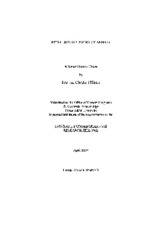| dc.description.abstract | Psychoanalysis and Film have been inseparable since Breuer and Freud published Studies on Hysteria the same year the Lumier ̌brothers released the first film, Train Entering the Station, in 1895. In the century since, films have dealt with psychoanalysis directly and indirectly. Research for this project consisted of three semester parts, the last being a semester of writing. During the first research period I conducted an analysis of over 40 films and their screenplays dealing with the subject of psychoanalysis in some manner that were also critically well received. The second time period was conducted in the documented actualities of the beginning of psychoanalysis, being in the case history of Anna O. (or Bertha Pappenheim in reality) and Freudian theory in Vienna in the late nineteenth century. This study of the methods and techniques in multiple past examples of films dealing with these themes, combined with an understanding of Freudian psychoanalysis is here presented creatively in this screenplay. In the script, I explore past connections between psychoanalysis and films that both have and have not been identified previously. The screenplay dramatizes Bertha Pappenheim's treatment with Dr. Breuer from 1880 to 1882 in Vienna, Austria. Bertha Pappenheim was the only surviving daughter of a rich Jewish family in the fin-de-si[e]cle era whose father was dying of tuberculosis. She cared for him night and day until she became too ill to continue. Dr. Breuer was then called in, but he identified her illness as hysterical almost immediately. This was the beginning of what was to become the most prominent case of hysterical symptoms, and the very first instance of the "talking cure" that defines our very basic understanding of psychoanalysis and therapy to this very day. The story is framed by Breuer's retelling of the story to Freud in 1886 upon his return from his studies in Paris. The screenplay represents the facts from the case history, biographies of all involved, and the city in that time period. Underlying this, however, is a symbolic and metaphorical account of psychoanalytic connections with film and of the overall themes of psychoanalysis. | en |


